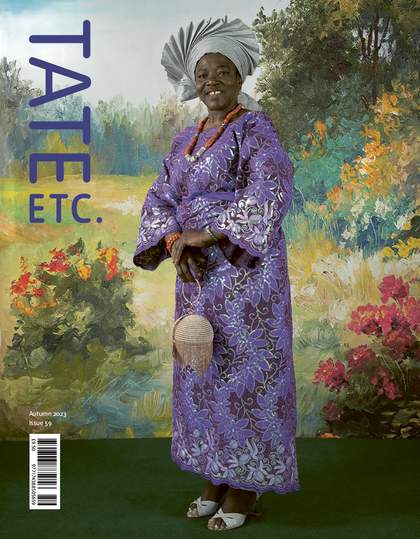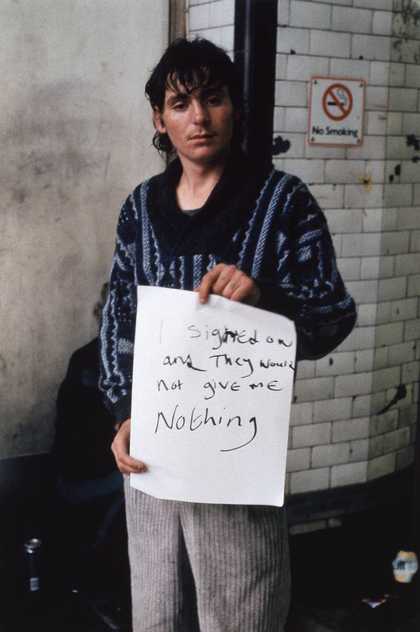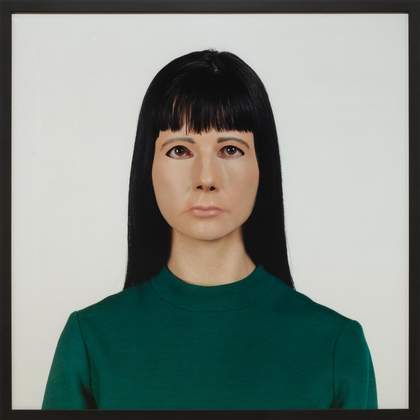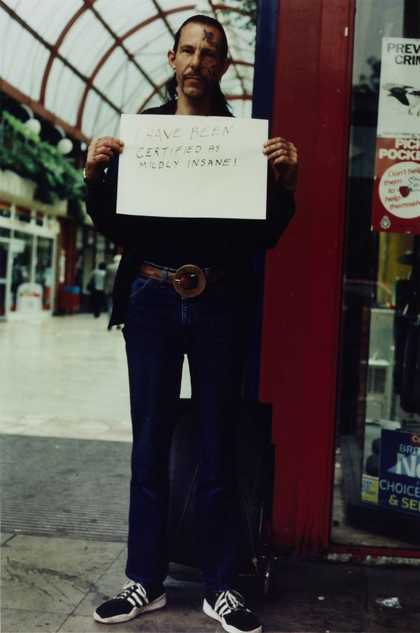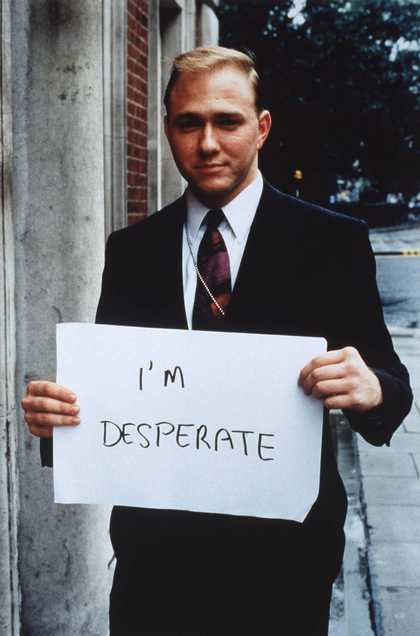
Gillian Wearing CBE
‘I’m desperate’ (1992–3)
Tate
© Gillian Wearing, courtesy Maureen Paley/ Interim Art, London
The Signs That Say What You Want Them to Say and Not Signs That Say What Someone Else Wants You to Say series took several months and various approaches before reaching its final form. Initially, in late 1991 and early 1992, I photographed people that I knew, first giving them signs to hold and then asking them to write their own ones.
It just didn’t work – the familiarity we had with each other meant that they wrote what they thought I wanted them to say. I almost gave up on the piece. But then, in early spring of 1992, I decided to go to Regent’s Park – somewhere I felt people would have time on their hands. There, I asked strangers to write down anything they wanted to.
I am a naturally shy person – and was even more so then – so this was out of my comfort zone. Nevertheless, I did manage to photograph three people. It wasn’t until I had the negatives developed that I realised there was something there. One photo was of a woman with a sign that read: ‘I really love Regent’s Park’. Although this message doesn’t sound particularly revelatory, it was the way she held the paper: it added an extra layer to the way the image might be read. This wasn’t something I had imagined would happen, and it was exciting.
When I left art school in 1990, I had considered going to film school. I was thinking about how important documentary TV had been to me when I was growing up, and the way it had helped to shape my understanding of the world, with all its differences. Documentaries showed me that most people had something interesting to say if they were asked. In the early 1990s, there had been a brief moment when TV documentary departments were being closed down. Documentaries had grown unfashionable. But I thought it was such an interesting area with so much more to offer, particularly in capturing the ‘now’, which later turns into a history.
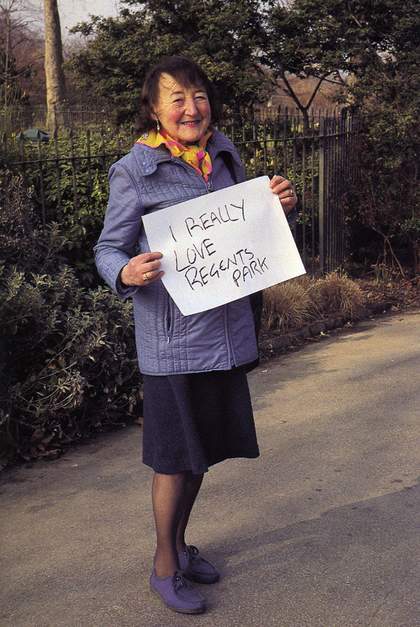
Gillian Wearing CBE
'I really love Regents Park' from the series Signs That Say What You Want Them to Say and Not Signs That Say What Someone Else Wants You to Say (1992–3)
© Gillian Wearing. All rights reserved, DACS 2023. Courtesy Maureen Paley, London, Tanya Bonakdar Gallery, New York and Regen Projects, Los Angeles
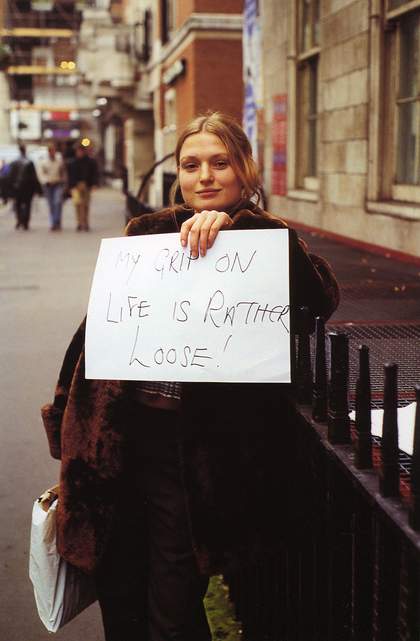
Gillian Wearing CBE
'My grip on life is rather loose' from the series Signs That Say What You Want Them to Say and Not Signs That Say What Someone Else Wants You to Say (1992–3)
© Gillian Wearing. All rights reserved, DACS 2023. Courtesy Maureen Paley, London, Tanya Bonakdar Gallery, New York and Regen Projects, Los Angeles
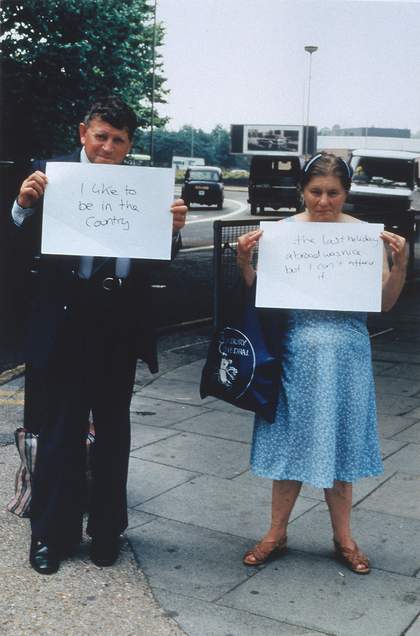
Gillian Wearing CBE
'I like to be in the country' from the series Signs That Say What You Want Them to Say and Not Signs That Say What Someone Else Wants You to Say (1992–3)
© Gillian Wearing. All rights reserved, DACS 2023. Courtesy Maureen Paley, London, Tanya Bonakdar Gallery, New York and Regen Projects, Los Angeles
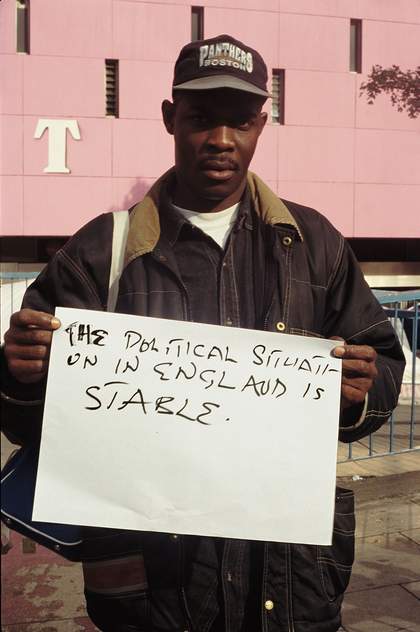
Gillian Wearing CBE
'The political situation in England is stable' from the series Signs That Say What You Want Them to Say and Not Signs That Say What Someone Else Wants You to Say (1992–3)
© Gillian Wearing. All rights reserved, DACS 2023. Courtesy Maureen Paley, London, Tanya Bonakdar Gallery, New York and Regen Projects, Los Angeles
In the Signs series, I wanted to capture as many people as possible. I would find a spot on a pavement and ask anyone that passed me to take part. Of course, most people don’t want to be interrupted during their daily routines, and individuals with clipboards in the 1990s were usually trying to sell something and best avoided. But if a person heard the first line of what I was saying, which was ‘I am an artist and I am doing a project where I am asking people to write anything they want on a piece of paper’, about 80 per cent of them would be intrigued enough to participate.
That success rate was down to the fact that so many passers-by thought it was a good idea. The immediacy of the vox pop element within the piece is like a snapshot, and the photos were taken in that way too – they weren’t staged. I used a 35mm Pentax camera and, not wanting to take up too much of anyone’s time, I only took one or two photos of each person. I never thought of the aesthetics of the image or asked people to pose in a certain way. I just asked them to hold up the paper.
After two years of working on the project, I noticed I had become more confident, but that there was also now an element of expectation as to what people might write. I knew then that it was time to end the piece. The process worked best when it was a surprise to both me and the participant.
I am so grateful to have had so many interesting people take part in writing a sign. I have often wondered whether I could have written something as fascinating, and I am not sure I could. It is impossible to imagine other people’s narratives, I’ve realised, but it’s rewarding to know that there are so many differences in every one of us.
Five prints from Signs That Say What You Want Them to Say and Not Signs That Say What Someone Else Wants You to Say were purchased in 2000. ‘I’m desperate’ is on display at Tate Britain.
Gillian Wearing is an artist based in London.

